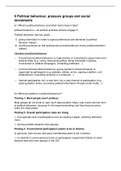6 Political behaviour, pressure groups and social
movements
6.1 What is political behavior and which forms does it take?
political behaviour = all political activities citizens engage in
Political behaviour has two goals…
1) giving information in order to signal preferences and demands to political
decision-makers
2) exerting pressure so that preferences and demands are met by political decision-
makers
Varieties of political behaviour
o Conventional political behaviour is organized by or connected to government and
political elites (e.g. voting, discussing politics, being interested in politics,
involvement in political campaigns, contacting politicians…).
o Unconventional political behaviour (giving signals to decisionmakers) is
organized by participants (e.g. protests, strikes, sit-ins, signing a petition, civil
disobedience, boycotting products or a producer…).
o Internet participation isn’t a new form, but a new channel of participation (e.g.
signing petition online, accessing political information through social media…).
6.2 What are patterns in political behaviour?
Finding 1: Most people aren’t political.
Most people do not know or care much about politics. Many vote (most common form
of political behaviour, because it’s the least demanding) and they become active
when the need arises.
Finding 2: Overall participation rates are rising.
⇨ Due sporadic acts of participation such as reading a paper, watching television
news…
⇨ Joining protests became more popular.
Finding 3: Conventional participation seems to be in decline.
In particular voter turnout and party membership seem to be in decline.
↔ no decline in unconventional forms of participation (experiment Dalton on what
became less and more popular in the US)
, Finding 4: There’s a continuous expansion in forms of participation.
⇨ Politics migrate to new locations, such as the Internet and social media.
⇨ Individualization of participation: personalized ‘participation repertoires’ and
lifestyle politics
Finding 5: Some people participate more than others.
⇨ People with a higher SES or socio-economic status (= a combination of class, how
people make their money, and status, how people spend their money, to form a
single measure of social stratification) have more resources and skills to participate.
⇨ Civic Voluntarism Model
People don’t participate, because…
o …they can’t (resources such as time, money or abilities are missing).
o …they don’t want to (engagement – they’re not interested or see no reason to be
involved).
o …none of their friends or colleagues invites them to join (recruitment).
6.3 What are pressure groups and social movements?
Civil society (voluntary organisations)
⇨ organisations with a political purpose, aiming to influence government
policies or actions such as pressure groups and social movements
pressure group = private and voluntary organisation that tries to influence or control
government policies but do not want to become the government (e.g. Amnesty
International, WWF…)
It is a general term to cover interest groups and cause groups. It’s sometimes
1 2
referred to as advocacy group, campaign group or lobby group.
1) interest group = the type of pressure group that represents occupational interests
(e.g. business and professional associations and trade unions)
2) cause group = the type of pressure group that promotes causes, policies or
issues of their own
(new) social movement = loosely knit organisations that try to influence government
policy on broad issues, including the environment, nuclear energy and nuclear
weapons, economic development, peace, housing, women and minorities rights (e.g.
#MeToo, Black Lives Matter…)





